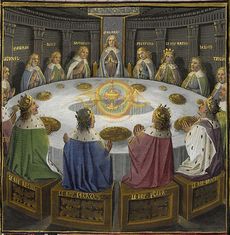King Arthur

The “once and future king,” fifth- or sixth-century King of the Britons and Guru of the mystery school at Camelot, an embodiment of El Morya. He drove the Saxon invaders from Britain, united the kingdom and established the order of the Knights of the Round Table, whose code of chivalry bound them to defend the helpless from the wicked and evildoers and to uphold the ideals of purity, truth, mercy, faithfulness and generosity .
According to Arthurian legends, after King Arthur was mortally wounded at Camlann by his bastard son (or nephew), Mordred, he was placed on a barge with three queens which drifted toward Avalon, an “island valley,” where, as Alfred Lord Tennyson wrote in Idylls of the King, “falls not hail, or rain, or any snow, nor ever wind blows loudly; but it lies deep-meadow’d, happy, fair with orchard lawns and bowery hollows crown’d with summer sea.” Some accounts say that Arthur would be healed of his “grievous wound” at Avalon and would return to rule over his people.

Sir Thomas Malory, who gathered together and chronicled the legends of Arthur in his fifteenth-century classic Le Morte d’Arthur, writes: “Yet some men say in many parts of England that King Arthur is not dead, but had by the will of Our Lord Jesu into another place; and men say that he shall come again, and he shall win the holy cross. I will not say that it shall be so, but rather I will say, here in this world he changed his life. But many men say that there is written upon his tomb this verse: Hic iacet Arthurus, rex quondam rexque futurus [Here lies Arthur, the once and future king].”
The Heart of the Inner Retreat is as “Avalon” where chelas of El Morya retreat in summer to be healed of the blows of karmic adversity affecting body, mind and soul. And the master himself takes refuge in this Western Shamballa—Gautama Buddha’s etheric/physical retreat in the West, an extension of his retreat over the Gobi Desert, which is centered over “the Heart” of this island valley.
Sources
Pearls of Wisdom, vol. 31, no. 34.
